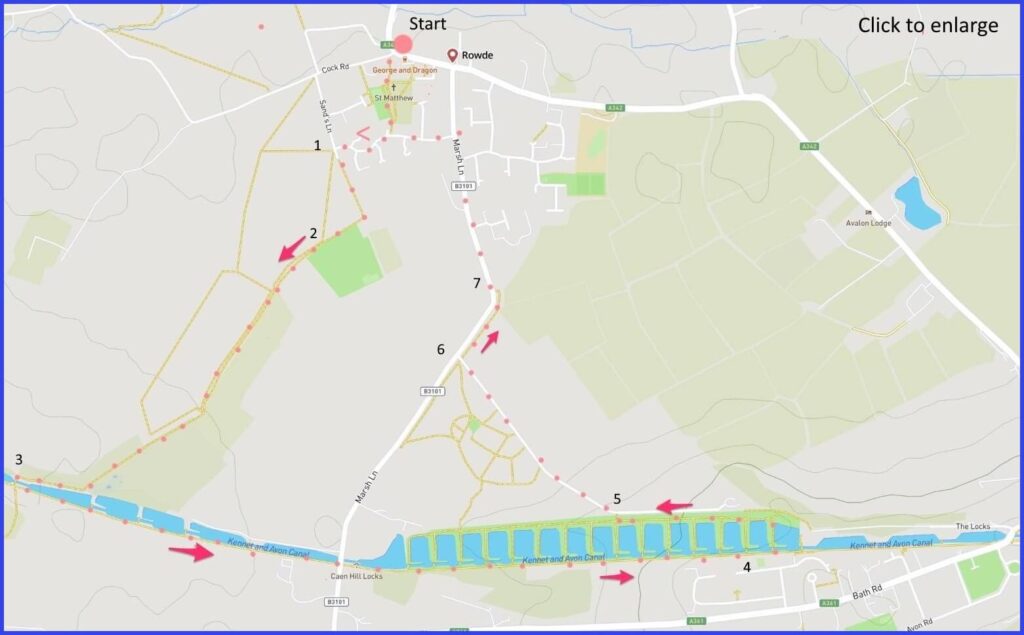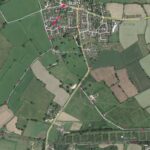SN10 2PN A walk around Rowde: about 3 miles distinguished by the system of locks on Caen Hill. Can be quite busy owing to its fame. Cafe midway. (click map to enlarge. Click here for arial view) Click here to download/print PDF. (There is a GPX route option here for phone/tablet download. But only follow this link after watching this GPX help video). Friendly warning: all files relating to walks are published here on good faith but on the understanding that users must be responsible for their own safety and wellbeing.
(Routes to take from map points + metres to next point)
0: From start, walk through the yard of St Matthew’s church. Cemetery path leads through gate to Rowde Court Road. Turn right and walk unti facing hedgerow at junction with Sands Lane. Take marked footpath in hedge to left. 350m
1: Walk diagonally across to right corder of field. 200m
2: From here there are parallel paths on each side of the hedgerow (joining at various points). Aim to end upon the rightwards path (as you walk down), following this towards the canal as shown. Pick up a straight route to just before the water where you head sharp right (parallel to canal on other side or headgerow until you reach crossing. 1km
3: Once crossed the path alongside the canal is a straight walk that takes you past the locks. (There is a cafe at the top). 730m
4: But just before cafe, cross to the path on the other side and follow that path back along the direction you have come. 500m
5: At the car park, join the lane (‘The Locks’) that takes you back to the main road junction. 550m
6: Walk the main road back into Rowde start. 750m
The pictures below are in the order things were seen on this walk. Clicking on any one will enlarge it (and the slideshow)
The walk
You need to take your luck on parking in the village, but it is not a great problem. The walk starts in the parish churchyard at the end of which the housing twists and turns a little until reaching Sands Lane where you turn left, quickly joining a long section of the walk which is across paths at the margin of fields. You are heading south in a pretty straight line towards the canal. The final section is a little overgrown and some improvisation might be needed to home in on the canal crossing point (3). After that it’s straight up the canal while you admire the locks and the boatpeople navigating them (if you are lucky). The route back to start is paved.
The locks
The starting village of Rowde is unexceptional. The George and Dragon pub is one of its oldest buildings, and you might take refreshment there (fish menu stressed). St Matthew’s Church deserves a visit; although mediaeval in foundation, much of it is now Victorian. The main matter of interest for this walk is the canal and its famous run of locks.
The Kennet and Avon canal was started in 1794 to service trade between Bristol and London under the impetus of French wars. The canal didn’t reach Devizes until 1807. Your reward on this walk will come from the extraordinary flight of locks. Those locks stretch across 2.5 miles, with 29 being here. The rise totals 237 feet up the canal. They are well shown off in this video. It takes around 5-6 hours to make the journey in a boat – regarded by many as the ultimate challenge. The locks were built in the early1800s to help connect London and Bristol. Impressive though it is, sadly what you see here cannot claim to be the rise with the most locks in the UK – that honour falls to Tardebigge.
This canal certainly contributed to prosperity in Wiltshire during the nineteenth century, thanks to the transport of coal to the West Wiltshire factory towns. Moreover to the right of the locks as you walk by them (grid reference ST982613) is a clay pit that was discovered and opened in 1810 as the flight itself was being constructed – around 2 million bricks were later traded down the canal from this discovery.
By the 1830s the canal was carrying 350,000 tons of traffic a year, half of which was coal. Most of this coal came from the Somerset coal field. Nevertheless, in the longer run it was never a great commercial success. The problem perhaps was that by the 1830s the railways were starting to be a faster and more efficient means of doing similar work.
The canal continues to attract some national attention – in part for hosting (i.e., the first 54 miles) the Devizes to Westminster canoe race (the second 54 miles being on the Thames). This marathon starts just up water from the final lock in this set. The first was in 1948 and it became known as the “DW”. A gruelling challenge. Competitor Paddy Ashdown commented: “We took 25 hours to finish the course, and I can only think of one person in history who has spent a worst Easter“
This was one of the few ‘Wiltshire walks’ where there were other people about. That must reflect the raw attraction of the locks (one of “the seven wonders of the waterways” etc). But it remains odd how few walkers there seem to be in this Wiltshire landscape. Particularly given its rather magical quality. On the other hand, although Wiltshire is one of the larger counties it is also one of the least densely populated. And outside of Stonehenge (and perhaps Salisbury) it is not an obvious destination for tourist stop overs or even day visits.



![[A]](https://wiltshirewalks.com/wp-content/uploads/2021/10/01rowde-150x150.jpg)
![[B]](https://wiltshirewalks.com/wp-content/uploads/2021/10/02rowde-150x150.jpg)
![[C]](https://wiltshirewalks.com/wp-content/uploads/2021/10/03rowde-150x150.jpg)
![[D]](https://wiltshirewalks.com/wp-content/uploads/2021/10/04rowde-150x150.jpg)
![[E]](https://wiltshirewalks.com/wp-content/uploads/2021/10/05rowde-150x150.jpg)
![[F]](https://wiltshirewalks.com/wp-content/uploads/2021/10/06rowde-150x150.jpg)
![[G]](https://wiltshirewalks.com/wp-content/uploads/2021/10/07rowde-150x150.jpg)